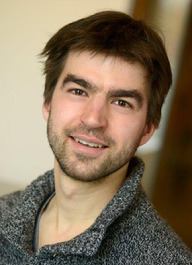Energy generation from mixing salt water and fresh water
Promotion date: January 17.
Promotor: Prof.dr.ir. Kitty Nijmeijer
| In a reverse electrodialysis (RED) stack of alternating anion and cation exchange membranes, with seawater and river water in compartments between these membranes, the voltage over each membrane is accumulated and can be used as a power source. Another approach, using capacitive electrodes, is a novel alternative. The performance is only slightly lower and operates without circulation, which simplifies the system and saves pumping costs. The highest power density measured, of a RED stack fed by seawater and river water, is 2.2 W/m2, using compartments as thin as 100 µm. The theoretical energy efficiency using a single electrode pair is 40 – 95%, depending on the fraction of sea/river water and the flow orientation. Higher efficiencies are obtained using segmented electrodes. Profiled membranes with ion conductive ridges that create flow channels for feed waters, make the use of spacers obsolete and reduce the pumping power by a factor 4-8. This would allow smaller intermembrane distances and reduces the ohmic resistance. The diffusive boundary layer and the associated non-ohmic resistance can be decreased significantly when the feedwater is uniformly distributed over its compartments. The prevention of colloidal fouling is, hence, very important. Fouling of RED stacks using natural seawater and river water is mostly inorganic and in lesser degree due to scaling and biofouling. Stacks with spacers are much more sensitive. Further, multivalent ions cause a dramatic decrease in obtainable power density. Reversal of electric current direction can be applied as anti fouling strategy. For large scale operation, RED can be competitive at a membrane price of approximately 4 euro per m2 of membrane area, estimated from current state of the art technology. |
Do you recall some memorable moments during your PhD period?
Reaching the increase in power density, quite in the beginning of the process, led to enthusiastic response, both from colleagues and from Wetsus, the research centre with whom we collaborated on this. It was a big surprise that varying the intermembrane distances was this profitable. We almost doubled the power density by doing so.
Also the conductive profiled membranes led to clear results, making spacers and plastic boundaries between the membranes obsolete. Good apparatus and production skills were needed here. The advantages of using micro milling techniques, instead of etching, proved profitable, as the ridges are nicely rectangular in shape making them function efficiently. Experience with similar membrane designs was available at the Membrane Science & Technology Group which allowed the profiled ion conductive membranes to be separated only by 200 µm in distance.
By using advanced experimental setups with high speed cameras, we were able to demonstrate the laminar flows in between the membrane ridges. Cross flow of the water feeds led to very high energy efficiencies. The use of twisted structures didn’t lead to better results as the mixing was optimal already. This is a bit of a pity, one could say, but it did lead to some great publications.
Were also some fundamental aspects involved?
One chapter, regarding the theoretical feasible efficiency of the system as a whole, was more fundamental in nature. Experiments and data analyses were at the core of this research. We only occasionally made use of simulation techniques.
Will this research be taken further?
REDstack is now building a prototype test site, at Breezanddijk, with a power generation capacity up to 50 kW. The main part of the research work will be centered towards filtering the feed waters. Filters, pipes and basins involved, do take the gross part of the installation area and volume. The RED stacks, eight in total, are modest compared to these: two meters in height, only on a compacted area.
The prospects are good for this type of technology. Estimations of about 200 MW installed capacity in the Netherlands are feasible, delivering electricity power for up to 200.000 households. The energy generation using salt and fresh water is a very promising technology in future energy strategies, as power can be generated by filling basins with salt and fresh water when no electricity is needed at a particular period of time. The IJsselmeer offers lots of potential to do so.
Did your research lead to some nice publications?
Articles appeared in Environmental Science & Technology, The Journal of Membrane Science, Energy & Environmental Science, to mention a few of them. From this project a total of nine publications appeared. Also two patents resulted from this work.
What are your future plans then?
I will be working with a companion in a spinoff company, on bringing a reversible process to market. We are investigating a closed system circuit to optimize the generation of energy from salt/fresh water feeds using coupled basins. We are studying the feasibility of such a system.
Parallel to that I would like to work on research projects for high tech companies bringing various ideas to the market.
I profited greatly from this four years of PhD work, as I am an all round scientist now, learning a great deal on physics and chemistry along the way. Combining knowledge and expertise from different fields can be very profitable, as I experienced during this project. Motivating people with whom one collaborates is very rewarding indeed. I learned to separate main issues from side issues in an early phase of research as well. Also I got inspired from other fields, for example from heat exchange technologies, similarly aiming to optimize process parameters.
How did you feel being part of the Mesa+ institute during your PhD period?
Most of my collaboration activities were taking place at Wetsus. I valued the presentations within Mesa+ with colleagues from various areas of research, working on energy and sustainability issues. Mesa+ is a renowned institute on nanotechnology in the Netherlands, known for its expertise. When working for Mesa+ one starts with a lead.

